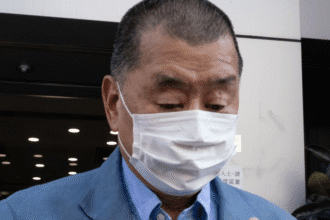Japan protests after Chinese surveillance aircraft enters its airspace; regional tensions escalate amid increased military activity
Chinese Spy Plane Breaches Japanese Airspace
Japan has accused China of breaching its airspace in what is considered the first direct violation by a Chinese surveillance aircraft. On Monday, a Chinese Y-9 reconnaissance plane allegedly entered the territorial airspace above the Danjo Islands for over two minutes, prompting Japan to scramble fighter planes. Tokyo responded quickly and forcefully to the encroachment.
- Japan protests after Chinese surveillance aircraft enters its airspace; regional tensions escalate amid increased military activity
- Chinese Spy Plane Breaches Japanese Airspace
- Rising Regional Tensions
- Silence from Beijing
- Okinawa and US Military Presence
- Chinese Military Activity Elsewhere
- Philippines Calls Out China
- Diplomatic Efforts Amid Rising Tensions
The Chief Cabinet Secretary of Japan said the act breached Japan’s sovereignty and was “utterly unacceptable.” Japan responded by calling a Chinese embassy official in Tokyo to formally protest and urge that Beijing act immediately to prevent similar events from happening in the future.
Rising Regional Tensions
Rising tensions in the Asia-Pacific area, where China’s increasing military aggression has raised questions among its neighbors and partners, set the scene for this airspace infringement. Key US friend Japan has been leading front-first in opposing China’s expansion aspirations in the area. The most recent intrusion emphasizes the possibility for more escalation, particularly given the Chinese military’s ongoing testing of regional security limits.
Japanese military authorities verified that they sent several alerts and warnings to the Chinese aircraft throughout the short invasion. Though no flare guns or weapons were used, the breach has significantly caused Tokyo anxiety about the increasing regularity and audacity of Chinese military operations in delicate regions.
Japan’s government immediately followed the occurrence and contacted Beijing diplomatically to show severe displeasure. The Japanese Foreign Ministry again underlined the necessity of China respecting international law and avoiding measures meant to cause instability in the area.
Silence from Beijing
Though Japan responded quickly and forcefully, Beijing has not officially commented on the event. This lack of reaction aligns with China’s usual policy in similar circumstances when formal apologies for these occurrences are sometimes delayed or absent altogether. In the meantime, Tokyo keeps a careful eye on Chinese military operations, especially in disputed areas.
Japan has recently expressed worries over the presence of Chinese ships in the East China Sea close to the Senkaku Islands. Both countries claim these uninhabited islands, sometimes called the Diaoyu Islands in China. Beijing and Tokyo have long been tense about the island’s wealth in oil and gas deposits.
Further aggravating the issue is the surge in Chinese naval activities around the islands recorded by Japan’s Defence Ministry. Chinese boats in the disputed areas are considered a component of China’s larger plan to undermine Japan’s authority over the islands and establish territorial claims.
Okinawa and US Military Presence
Japan’s Okinawa Island, the site of Asia-Pacific’s most significant US military installation, adds to the local hostility. With the US keeping a robust military presence in Japan, Taiwan, the Philippines, and South Korea, this strategic site acts as a crucial center for American soldiers. Consequently, Okinawa has taken a front-row seat in the mounting conflict between the US and China.
Expert in Chinese foreign policy Ian Chong noted that although this current intrusion seems concerning, it aligns with China’s prior actions in the area. “China tends not to venture directly into Japanese airspace, but its actions are part of a broader pattern of increasing military assertiveness in the Asia-Pacific,” Chong remarked.
Chinese Military Activity Elsewhere
Furthermore, China’s solid military posture is felt elsewhere in the area. Taiwan’s defense ministry revealed last month 66 intrusions by Chinese military aircraft in a single day beyond the so-called “median line,” an artificial border separating Taiwan from the Chinese mainland. With hundreds of occurrences recorded over the previous two years, these invasions have grown even more regular.
Beijing does not acknowledge the median line; hence, its frequent transgressions have raised questions about the likelihood of a military war in the Taiwan Strait. Taiwan has responded by increasing its defense policies, and the world community has carefully observed the matter.
Philippines Calls Out China
The Philippines has also charged China with upsetting the balance in the area. After a conflict in the South China Sea, Manila has named China the “greatest disrupter of peace” in Southeast Asia. The conflict happened on a resupply trip for Philippine fishermen in a disputed area, therefore underscoring China’s more aggressive posture in that area.
Gilberto Teodoro, the Philippines Defence Secretary, cautioned that China’s moves reflect a long-term power struggle in the area. “This is a fight, hence we should anticipate these kinds of behavior from China. We must be ready to expect and become accustomed to these unlawful behaviors,” Teodoro stated.
Diplomatic Efforts Amid Rising Tensions
Diplomatic initiatives to handle the mounting security issues are in progress while hostilities keep rising. Currently in Beijing negotiating with China’s Foreign Minister, Wang Yi, US National Security Advisor Jake Sullivan is These discussions are supposed to center on handling the several flashpoints in the area, including military operations and territorial conflicts.
The US and its partners still prioritize efforts to stop rampant escalation, but negotiating an atmosphere of growing tension remains difficult. The globe continues to observe the Asia-Pacific region’s balance of power becoming progressively more unstable.
China Issues Travel Warning to Japan Amid Rising Taiwan Tensions








